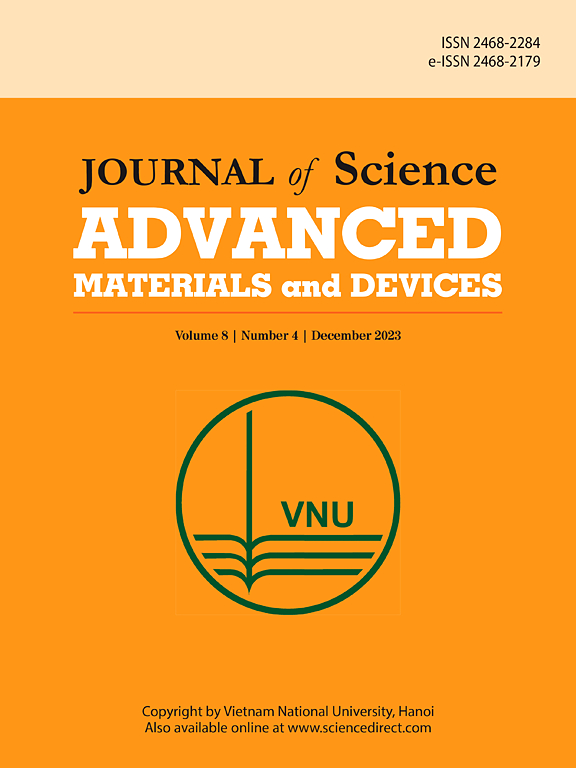Green synthesis of AgCu2O nanocomposites via Melastoma saigonense extract: Physicochemical characterization and multifunctional bioenvironmental applications
IF 6.8
3区 材料科学
Q1 MATERIALS SCIENCE, MULTIDISCIPLINARY
Journal of Science: Advanced Materials and Devices
Pub Date : 2025-07-14
DOI:10.1016/j.jsamd.2025.100953
引用次数: 0
Abstract
The present research emphasizes production of eco-friendly AgCu2O nanocomposites from a medicinal plant extract derived from Melastoma saigonense (Kuntze) Merr. seeds. AgCu2O samples at varying Ag concentrations (1, 3, and 5 mol%) were produced and then characterized using thermogravimetric analysis (TGA), X-ray diffraction (XRD), ultraviolet–visible diffuse reflectance (UV–Vis DRS), Fourier transform infrared spectroscopy (FTIR), X-ray photoelectron spectrometry (XPS), scanning electron microscopy (SEM), transmission electron microscopy (TEM), energy dispersive X-ray spectroscopy (EDS), a vibrating-sample magnetometer (VSM) and dynamic light scattering (DLS). The formation of AgCu2O was validated by XRD, FTIR, and XPS results. A morphological investigation combined with EDS demonstrated that Ag nanoparticles appear to cover the surface of Cu2O nanoparticles, producing AgCu2O, whereas phytochemicals function as gel-like clusters on the surface of nanocomposites. The AgCu2O samples were spherical, with particle sizes ranging from 3.08 to 16.47 nm. Addition of 3 mol% Ag to Cu2O produced a 3 %AgCu2O with smaller particle sizes (about 6.73 nm) and higher colloidal stability. In comparison to other samples with different silver loadings, 3 %AgCu2O exhibited higher saturated magnetization (MS) and enhanced antibacterial activity. In the assays for α-Amylase and α-Glucosidase inhibition, the IC50 values of 3 %AgCu2O were 6.19 μg/mL and 95.14 μg/mL. The cytocompatibility of the 3 %AgCu2O was evaluated using RAW 264.7 cells, which showed no toxicity to macrophages and suppressed LPS-induced nitric oxide overproduction. Furthermore, the adsorption of methylene blue (MB) by 3 %AgCu2O was 84.6 % under dark conditions. The resultant nanocomposite may be used for biomedical applications and environmental remediation.

紫草提取物绿色合成AgCu2O纳米复合材料:理化表征及多功能生物环境应用
本研究重点研究了从药用植物Melastoma saigonense (Kuntze) Merr中提取的AgCu2O纳米复合材料的生产。种子。采用热重分析(TGA)、x射线衍射(XRD)、紫外-可见漫反射(UV-Vis DRS)、傅里叶变换红外光谱(FTIR)、x射线光电子能谱(XPS)、扫描电子显微镜(SEM)、透射电子显微镜(TEM)、能量色散x射线能谱(EDS)、振动样品磁强计(VSM)和动态光散射(DLS)。通过XRD、FTIR和XPS验证了AgCu2O的形成。形态学研究结合能谱分析表明,Ag纳米粒子似乎覆盖在Cu2O纳米粒子表面,产生AgCu2O,而植物化学物质则在纳米复合材料表面以凝胶状团簇的形式发挥作用。AgCu2O样品呈球形,粒径范围为3.08 ~ 16.47 nm。在Cu2O中加入3mol %的Ag,可以得到粒径较小(约6.73 nm)且胶体稳定性较高的3% AgCu2O。与其他不同银负载的样品相比,3% AgCu2O具有更高的饱和磁化强度(MS)和增强的抗菌活性。在α-淀粉酶和α-葡萄糖苷酶抑制实验中,3% AgCu2O的IC50值分别为6.19 μg/mL和95.14 μg/mL。使用RAW 264.7细胞对3% AgCu2O的细胞相容性进行了评估,结果显示,AgCu2O对巨噬细胞没有毒性,并抑制了lps诱导的一氧化氮过量产生。此外,在暗条件下,3% AgCu2O对亚甲基蓝(MB)的吸附率为84.6%。合成的纳米复合材料可用于生物医学应用和环境修复。
本文章由计算机程序翻译,如有差异,请以英文原文为准。
求助全文
约1分钟内获得全文
求助全文
来源期刊

Journal of Science: Advanced Materials and Devices
Materials Science-Electronic, Optical and Magnetic Materials
CiteScore
11.90
自引率
2.50%
发文量
88
审稿时长
47 days
期刊介绍:
In 1985, the Journal of Science was founded as a platform for publishing national and international research papers across various disciplines, including natural sciences, technology, social sciences, and humanities. Over the years, the journal has experienced remarkable growth in terms of quality, size, and scope. Today, it encompasses a diverse range of publications dedicated to academic research.
Considering the rapid expansion of materials science, we are pleased to introduce the Journal of Science: Advanced Materials and Devices. This new addition to our journal series offers researchers an exciting opportunity to publish their work on all aspects of materials science and technology within the esteemed Journal of Science.
With this development, we aim to revolutionize the way research in materials science is expressed and organized, further strengthening our commitment to promoting outstanding research across various scientific and technological fields.
 求助内容:
求助内容: 应助结果提醒方式:
应助结果提醒方式:


